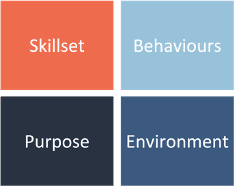One of the biggest impacts of the COVID-19 pandemic has been that people have started to look at work differently. More and more organizations are prioritizing mental health and employee well-being to improve employee engagement and retention.
While practices such as resilience training and “No Zoom Days” are well-intentioned, how much of this actually translates into employee well-being? One reason many well-being practices lose steam is the lack of integration with the organizational routines and processes.
What is well-being?
Well-being is defined by the Oxford English Dictionary as “the state of being comfortable, healthy, or happy.” It means having good mental health, high life satisfaction, a sense of meaning or purpose and an ability to manage stress. It is comprised of four core elements:

- a set of skills to be built,
- a set of behaviors to practice,
- a purpose to be discovered, and
- an environment to help foster it.
So, when organizations try to further well-being through practices which cater to only one of the core elements (for example: skill building through a stress management training program), the impact if any, is fleeting or non-existent.
For organizations to make well-being a way of life, they must look at it from a holistic perspective. They need to harness all four elements to create a culture of wellness within the organization to ensure employees show up with their best selves and give their best performance.
Look at well-being holistically
Ask key questions:
- What are the skills employees need to better cope with the pressures of work/life?
- How can we encourage employees to build positive mindsets/behaviors?
- How can we as an organization become more purposeful?
- How can we make our employees more purposeful?
- How can we create an environment that encourages well-being?
- How can we build well-being practices into our daily rituals?
Use all four core elements of well-being
Element 1: Building skillset
The most important skills required to build well-being for employees are:
- resilience skills
- positive thinking skills
- mindfulness skills
These can be built via virtual or in-person trainings over time. I recommend holding fewer training sessions and emphasizing building the behaviors required to practice well-being.
Element 2: Harnessing purpose
A purposeful organization fosters purposeful employees. What are the core values that drive us as an organization? Are employees aligned with the organizational purpose? This can be done through:
Leadership off-sites: The leadership team gets together to chalk out the organizational values and mission and crafts a purpose for the organization. This can then be translated across the workplace using various communication modalities.
Incorporating purpose in day-to-day organizational practices: Zappos is a great example. Right after hiring, within the first two weeks, the HR manager says “I know some of you are really excited about working at Zappos. I also know some of you are having second thoughts. If so, you have an opportunity to leave now. If you leave now, we will give you a leaving bonus of $2,000.” Zappos had started this process by giving a $500 bonus but it worked so well they increased it to $2000. They only wanted employees who were aligned with the organizational values to work with them.
Purpose building workshops: You can also drive individual purpose for employees across the organization by holding workshops where they are encouraged to delve into their individual life purpose and use that to show up as their best selves at work. A Fortune 500 company I consult for has used this approach successfully to drive purpose for employees across the globe.
Element 3: Leveraging behaviors
Make mindfulness behaviors easy to do and create triggers to remind employees of the importance of well-being practices. Make well-being rituals part of the organizational DNA. For example:
Mindfulness during meetings: A lot of companies have started playing “pileup” during their in-person meetings. Simply ask everyone to pile all of their smartphones in the middle of the table, then ask them to keep them there until the end of the meeting. This ensures people are more mindful and less distracted during meetings.
Walk while you talk: A California-based skincare brand Murad came up with a way to encourage walking meetings. They painted a walking track in their global headquarters. The track, which snakes through and around the floor of their offices, enables employees to stretch their legs and discuss work on the fly.
Element 4: Environment
An often overlooked part of creating wellness for employees is the organizational environment. Studies show environment plays a crucial role in how people behave in various scenarios.
For example, when Google realized employees were eating unhealthy amounts of the M&Ms freely available in various corridors at the office campus, they moved the M&Ms from transparent jars into opaque ones. They also put healthy snacks such as almonds and nuts in transparent jars next to the M&Ms. Over the course of seven weeks at Google’s New York office, this simple environmental change ensured their employees ate 3.1 million fewer calories in M&Ms.
How do you encourage employees to exercise more? Human capital management company Ceridian installed treadmill workstations for employees to walk while on conference calls, web meetings or working on their laptops.
While we are talking about the physical environment here, there may be immense benefit in also considering the psychological environment created at the workplace. The more elements you can trigger, the better the chances of building a culture of wellness at work.












